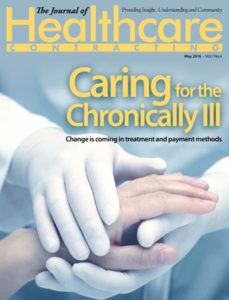Change is coming in treatment and payment methods
 There are no easy answers to how providers should best care for the many Americans with chronic – and sometimes multiple chronic – diseases. Nor are there easy answers to how physicians and other caregivers, such as hospice or home care staff, should be compensated for these complex cases.
There are no easy answers to how providers should best care for the many Americans with chronic – and sometimes multiple chronic – diseases. Nor are there easy answers to how physicians and other caregivers, such as hospice or home care staff, should be compensated for these complex cases.
Even so, JHC readers should rest assured that change is coming on both counts.
In May 2015, U.S. Senate Committee Finance Chairman Orrin Hatch and Ranking Member Ron Wyden announced the formation of a bipartisan chronic care working group. Its mission was – and remains – to draw up policies for caring for the chronically ill that meet three goals:
- Increase care coordination among individual providers across care settings.
- Streamline Medicare’s current payment systems to incentivize the appropriate level of care for beneficiaries living with chronic diseases.
- Facilitate the delivery of high-quality care, improve care transitions, produce stronger patient outcomes, increase program efficiency, and reduce growth in Medicare spending.
From August through October 2015, the working group collected 530 comments from stakeholders, and held 80 stakeholder meetings. Then, in December, it issued proposed six recommendations in a 30-page document, for which the group is now accepting public comments.
- Receiving high-quality care at home. Home-based primary care teams allow providers to spend more time with their patients to better coordinate healthcare services, perform medical and functional assessments in a familiar and safe environment, and accept increased accountability for all aspects of the patient’s care plan, said the working group. This approach seeks to improve patient outcomes while reducing healthcare costs – often accomplished by preventing the need for more expensive care in institutional settings.
- Advancing team-based care. Today many chronically ill beneficiaries, particularly those enrolled in traditional Medicare, lack access to a proven, team-based care structure, said the working group. Providing such people with an interdisciplinary healthcare team is a model that, in certain settings and under specialized arrangements, can lead to stronger patient outcomes and reduced overall expenditures.
- Expanding innovation and technology. Innovation in benefit design and technology, such as telemedicine, can increase beneficiary access to services that are critical to improve chronic disease management.
- Identifying the chronically ill population and ways to improve quality. Plans and providers that participate in the Medicare program should be appropriately paid for and evaluated on the care that they provide to chronically ill Medicare beneficiaries, wrote the working group.
- Empowering individuals and caregivers in care delivery. Providing timely, accurate tools and information can empower Medicare beneficiaries to better manage their chronic diseases, concluded the group. These strategies can improve healthcare quality and outcomes, and reduce costs to both beneficiaries and the Medicare program.
- Other policies to improve care for the chronically ill. Certain gaps in knowledge should be due to their potential high impact on chronic disease management, the group recommended. Examples include studies of obesity drugs and medication synchronization.
Physicians respond
Among those responding to the working group’s recommendations was the American College of Physicians, which represents 143,000 internal medicine physicians, subspecialists and students.
The College supported many of the working group’s recommendations, including:
- Improving access to chronic care and ensuring appropriate reimbursement for complex chronic care management.
- Eliminating beneficiary cost-sharing for chronic care management services.
- Integrating care for behavioral health conditions in a primary care setting.
- Improving the process for development of quality measures for chronic conditions, including filling critical measure gaps.
- Allowing increased flexibility for accountable care organizations (ACOs) to better design packages of services for patients with chronic conditions, support patient engagement, choose the best approach for patient attribution to meet their needs, and expand the use of telehealth to treat their patients with chronic conditions
The College also recommended that the Finance Committee consider:
- Creating a new code bundle for diabetic care management.
- Providing reimbursement for e-consultations between hospitalists and primary care physicians, and specialists and primary care physicians.
- Expanding the implementation of the patient-centered medical home as a means of improving care for patients with chronic illness.
- Delaying expansion of “Meaningful Use” to include activities involved in the coordination of the care of patients with chronic conditions until there is better evidence about the best ways to use health information technology to perform that coordination.
